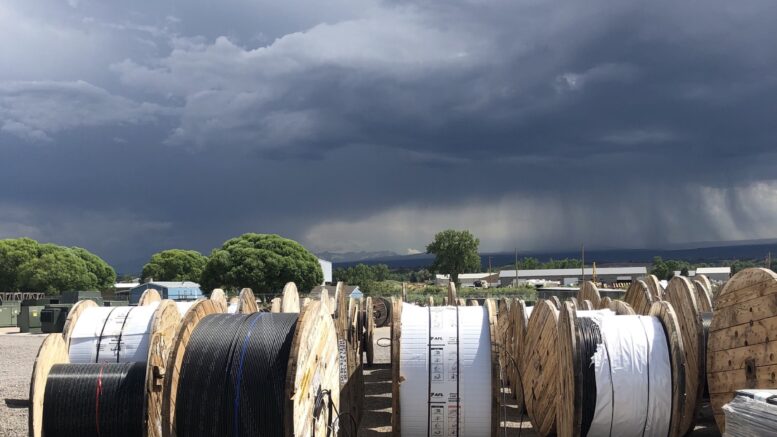Colorado is getting nearly $1 billion in broadband funding from the federal government — money that offers unprecedented opportunities to connect 99% of the state and open economic development to areas that now have little chance at attracting it.
But the Colorado Office of Information Technology and the state’s U.S. senators want most or all the $826 million in Broadband, Equity, Access and Deployment (BEAD) money to go to rural providers, nonprofits and local governments — not traditional internet service providers. And while several larger providers offered full support to the program and its goals of near-universal access, they questioned whether those goals are achievable if the most experienced and well-staffed companies in the industry are not included in the process.
Colorado OIT leaders, who in July announced receipt of the funding as part of the 2021 Infrastructure Investment and Jobs Act, are developing a proposal on how they will divvy out the funds to connect some 190,000 households that can’t access high-speed internet now. If approved by the National Telecommunications and Information Administration early next year, the money will be delivered in two lump sums, and the work must be done by 2027.

Brandy Reitter, executive director of the Colorado Broadband Office, speaks at a July news conference announcing that Colorado is getting $826 million in federal broadband funding.
Broadband’s economic-development importance
Broadband also will connect businesses in further-flung locations, allow farmers acting as businesses to have access to a resource increasingly important to their sector and provide remote-work options in regions that essentially are closed to skilled professionals now because of their inability to connect seamlessly to major cities. Vail Valley Partnership President/CEO Chris Romer said that for many towns in his area, broadband installation in the past decade has had “a huge impact on our business vitality and … our continued economic diversification.”
Montrose Mayor Barbara Bynum said the fiber that connected her town to high-speed internet nine years ago has helped it to attract jobs and to retain the headquarters of Mayfly Outdoors, a manufacturer of internationally distributed fly-fishing equipment. But there are areas not far outside the Western Slope town that have no reliable options, and the BEAD money can ensure that they and further-flung locations have the same opportunity to create jobs that aren’t just service positions and that help their local economies to bloom, she said.
“When I’m invited to meet with a prospective business owner, the fiber and the airport are huge selling points to what they need to do business,” Bynum said. “They can look around and see the access to the public lands that makes this place so attractive. But if they didn’t have the internet — and oftentimes if they didn’t have the airport — it would be a moot point to whether they could do business in the area.”
How Colorado will use broadband funding
Under former Gov. John Hickenlooper, the state began mapping out areas without high-speed broadband access. Those are largely very rural places but also include some location on the “urban fringe” to which companies haven’t had the financial ability or incentive to run needed fiber, said Brandy Reitter, executive director of the Colorado Broadband Office.

U.S. Sen. John Hickenlooper speaks at the Colorado Chamber of Commerce congressional luncheon on Aug. 17.
Once the state receives federal approval for its plan to spend the $826 million, it will seek applications from local partners to begin connecting those areas that are now off-ramps on the information superhighway. It also will work through workforce training centers and in partnership with trade associations, labor unions and the educational system to teach 3,000 people how to build out broadband, with the goal of having 1,500 new sector workers by 2026, Reitter said.
This isn’t the first time the federal government has invested in growing broadband nationally, though it is the first time it’s distributed funding directly to states to plot their own plans for covering the greatest number of people. About a decade ago, the Connect America Fund began doling out billions of dollars to providers to expand broadband access — and disputes over the way that money was used have led some BEAD proponents to say they need to take a different tact this time.
Reitter said that she expects most of the money to go to smaller firms, rural cooperatives, nonprofits and local governments because they are the entities that serve these unconnected regions. Funding recipients then will be expected to provide service to the areas, as applications for the funding will contain requirements that they provide five years of compliance and monitoring of the lines and that the service be affordable to residents, she said.
Big providers or small providers?
“The traditional ISPs and the bigger incumbents, they typically are not in rural Colorado,” Reitter said in an interview. “We have one time to do this. You don’t get a shot at a billion dollars again.”
The state’s U.S. Senators — Democrats Hickenlooper and Michael Bennet — expressed even stronger sentiments that they believe the money should be directed away from large firms and into the hands of local governments and providers.
Bennet said in early July that the last pot of money that went to big telecom firms “left rural America out, left rural Colorado out,” according to the Denver Post. And Hickenlooper told The Sum & Substance that he too felt the federal government last decade spent a lot of money without getting the return on investment it needed from the largest companies.

U.S. Sen. Michael Bennet speaks in July at a news conference announcing Colorado is receiving $826 million in federal broadband funding.
“We didn’t get everything we always thought we should,” Hickenlooper said before speaking at the Colorado Chamber of Commerce’s congressional luncheon earlier this month. “So, in these rural areas, the smaller businesses that tend to neighbors seem to be the best choice.”
Traditional providers want new broadband funding
Some in the industry have said that the shortfall in geographic expansion of broadband was due more to the previous program running out of money, however. And several companies that are leaders in the sector argue that the state should rethink its approach so that it can use the expertise of companies that know how to install infrastructure in the most efficient and effective way possible and have a proven track record of serving customers.
Lumen, known formerly as CenturyLink, received money through the Connect America Fund and met all its obligations to the federal government, noted Mark Soltes, its vice president of state government affairs. It has more than 1 million customers in a state where it’s laid more than 26,000 fiber miles, and it’s now concerned not just that it may not be able to participate in the new program but that the state would rely solely on smaller providers rather than expertise of experienced companies to provide last-mile solutions.
“This is our business … It’s about understanding broadband infrastructure and the ever-growing demand for higher speeds and newer technologies. Larger, more experienced providers are well-positioned to make the necessary network investments and deliver on innovation,” Soltes said. “With our fiber infrastructure, we connect to our competitors, which helps everyone. We’re a major part of the internet ecosystem and we strongly support closing the digital divide. Policymakers should be trying to get the biggest bang for their dollars and making this program an all-of-the-above opportunity.”
A question of digital equity?
Leaders at Comcast — which made $1.2 billion in technology and infrastructure investments in Colorado over the past three years — feel similarly, saying they’ve been doing a lot of work on digital equity that involves not just building networks but ensuring people have access to them. While some areas of the state are harder to fit into a business model because of the high cost of building fiber through rough terrain to serve small numbers of people, the whole idea of federal subsidies is to allow expansion to areas that weren’t feasible previously, said Jon Lehmann, senior director of local government affairs for the Mountain West region.
Even Romer argued that while smaller firms may be the best choice for many of the last-mile expansions, larger partners shouldn’t be off the table because of the need to use all hands to get this work done.
“This is one of those unique opportunities — government and the private sector being able to partner in a way to connect and help all these Colorado residents be able to grow their livelihood,” Lehmann added. “So, I think the opportunity is almost endless in its benefits — if this is done in a way that’s efficient and makes sense.”
